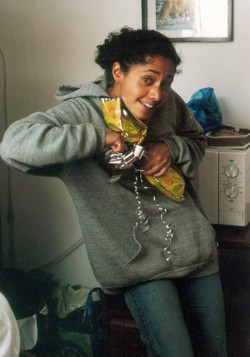Joyia Chakungal

M.Sc. Thesis
40Ar/39Ar Study of The Northwestern Reindeer Zone, Trans-Hudson Orogen: Reindeer Lake, Saskatchewan.
(PDF - 16.3 Mb)
When studying ancient orogens, an important though challenging task is to determine the processes that led to its exhumation. Processes that exhume deeply buried rocks are synorogenic erosion and normal faulting, which exhume rocks at rates reaching upper limits of > 510 km Ma1; and ductile thinning of the crust and postorogenic erosion which are characterized by slow exhumation rates (< 5 km Ma1). In the absence of direct evidence for exhumation processes, the most effective approach is to use thermochronological techniques in which radiometric ages are obtained from a number of minerals characterized by different closure temperatures (Tc). Ages are used to constrain the time at which the rock passed through a particular mineral's Tc. In the case of normal faulting, rocks preserve an asymmetric distribution of ages with an abrupt discontinuity at the normal fault. Rocks exhumed by postorogenic erosion preserve a smoothly varying coolingage pattern with few or no structural breaks.
Along the shores and islands of Reindeer Lake, Saskatchewan, the Paleoproterozoic TransHudson Orogen comprises a collage of deformed and metamorphosed sedimentary, and mantlederived arc volcanics and plutonic terranes collectively termed the Reindeer Zone (RZ). From south to north, it includes the Glennie, Kisseynew and La Ronge domains, which were trapped between the Archean RaeHearne and Superior cratons during continentcontinent collision at ca 1850 1800 Ma. Peak metamorphism throughout the orogen occurred during the interval ca. 1830 1790 Ma. Metamorphic grade throughout the zone varies from transitional granulite facies in the Kisseynew domain, to upper amphibolite facies at the northern margin of the La Ronge domain, but does not display marked variations across domain boundaries. Similarly, UPb monazite and titanite ages obtained by previous workers, also do not display marked variations across domain boundaries, but show apparent uniformity in metamorphic and cooling ages across the orogen.
In the current study, 28 samples collected from a geologically wellconstrained, 200 km south north transect across the RZ and into the Wathaman Batholith and Archean Peter Lake domain along Reindeer Lake, were analyzed using the 40Ar/39Ar method of thermochronology. Analyses were conducted on hornblende (Tc = 500 0C), muscovite (Tc = 350 0C) and Kfeldspar (Tc ˜ 260 00C) grains to constrain the time at which the RZ cooled through the Tc of each mineral. Cooling rates calculated from the data suggest the RZ cooled at an average rate of ~ 5.0 0C/My. Further north, the Wathaman Batholith cooled at an average rate of 2.6 0C/My. Preservation of homogeneous hornblende ages across much of the transect suggests the RZ cooled to 500 0C by ~ 1770 Ma, implying that much of the zone reached thermal equilibrium at that time. Preservation of the youngest hornblende ages in the southern La Ronge domain, above the Duck Lake shear zone (DLSZ), suggests that at ~ 1740 Ma, following thermal equilibration, there was localized fault movement within the DLSZ. Distribution of uniform 40Ar/39Ar hornblende ages on either side of the DLSZ suggests that exhumation of the Reindeer Zone to its present structural level was dominated by the process of postorogenic erosion until ~ 1770 Ma. Preservation of younger hornblende ages within the DLSZ suggests exhumation of the southern La Ronge domain was dominated by faulting at ~ 1740 Ma, possibly as a consequence of northwestward migration of the Archean Superior craton.
Keywords:
Pages: 188
Supervisors: Rebecca A. Jamieson and Peter Reynolds



